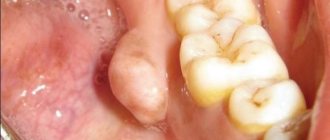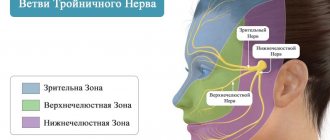Osteomyelitis of the jaw
In surgical dentistry, osteomyelitis of the jaw is considered a common disease. Osteomyelitis of the jaw (ICD 10 code M.86) - (osteomyelitis from the Greek osteon bone + myelos bone marrow) is a severe inflammation affecting soft tissue elements, bone tissue and periosteum. It is accompanied by necrotic damage (decomposition) of the bone, which subsequently leads to its deformation. The development of the pathological process is provoked by bacteriological microorganisms that penetrate the jaw bone together with infected blood or in response to post-traumatic damage - fractures and wounds.
Osteomyelitis of the jaw (ICD code M.86) is a serious pathogenic process that, without timely treatment, can lead to complications. The risk group consists of male patients under 40 years of age. The primary and main thing is to identify the symptoms of the disease, thanks to a clear differential diagnosis. Thus, dental surgeons from the West Dental family clinic network in Yanino-1 and Vsevolozhsk will help diagnose and treat the problem at a reasonable price.
The causes and symptoms of the disease, which specialist to contact and how to treat - we will consider below in the article.
What is it and how to treat it?
Osteomyelitis is an inflammation of the bone marrow with a tendency to progress.
This is what distinguishes it from the widespread dentoalveolar abscess, dry socket, and osteitis seen in infected fractures. Osteomyelitis affects adjacent cortical plates and often periosteal tissues. In the era of preantibiotics, osteomyelitis of the mandible was not uncommon. With the advent of antibiotics, the disease began to be detected less frequently. But in recent years, antimicrobial drugs have become less effective, and the disease has reappeared.
Causes
The main provocateur of the formation of osteomyelitis in the upper and lower jaw is considered to be pathogenic microflora - streptococci and anaerobes, present in the oral cavity of every person. They aggravate the infection, affecting the soft and hard components of the mouth. There are several ways to penetrate deeper into the pathological process:
- Missed dental caries, which destroyed the enamel with dentin and penetrated into the pulp chamber.
- Traumatization – crack, violation of the sealing material. The damage must be deep (fracture of the HF or LF) to provoke an infectious process (staphylococci).
- Chronic infection occurs in other parts of the body. Pathological microorganisms can reach the jaw through the lymph nodes or blood vessels (ENT organs).
In most patients, osteomyelitis is located on the lower jaw, since the lower units are more likely to be affected by caries or trauma. Also, people with immunodeficiency and blood diseases are at risk, because they have difficulty healing wound surfaces and the immune function of the body is weakened.
Other factors:
- smoking;
- alcohol;
- Diabetes type I and II;
- eating disorders;
- syphilitic infection;
- radiation and chemotherapy.
If you miss and do not treat acute osteomyelitis in the upper or lower jaw, then the process becomes chronic, which is more difficult to treat and leads to many complications.
Causes of osteomyelitis
The main cause of osteomyelitis is pathogenic microorganisms. In most cases, the disease is caused by anaerobic bacteria and streptococci. The peculiarity of the development of the inflammatory process is that these bacteria are always in the oral cavity. The development of osteomyelitis begins when microorganisms have access to bone tissue.
Routes of infection.
- Carious cavity.
- Deep tooth trauma (crack, fracture).
- Poor quality filling.
- Fracture of the jaw bone.
The cause may be a chronic infection of the ENT organs. Bacteria travel to the jawbone and teeth through the lymphatic or circulatory system.
Osteomyelitis of the lower jaw develops predominantly, since injuries and caries of the teeth of the upper jaw occur half as often.
Classification
According to the method of penetration of osteomyelitis infection on both jaws, a classification has been compiled:
- Hematogenous - pathogenic microorganisms move through the blood from other foci of infection. This feature is characteristic of secondary pathology of the upper oral part, which develops against the background of another disease (scarlet fever, diseases of the ENT organs). The bone elements of the oral apparatus are primarily affected, followed by the gingival tissue.
- Odontogenic – infection comes from a tooth, damaged pulp or root (pulpitis, periodontitis, cyst, alveolitis).
- Traumatic – advanced fractures and injuries of the maxillofacial area.
According to the symptoms, the process happens:
- spicy;
- subacute;
- chronic.
By distribution:
- local (with clear boundaries);
- vague (diffuse).
Differential diagnosis
Differential diagnosis of osteomyelitis with other diseases that have similar symptoms is important, since an incorrect diagnosis can lead to an incorrect choice of treatment tactics and ineffective therapy. All this increases the risk of an unfavorable outcome of the disease and a poor prognosis for future health.
The differential diagnosis of osteomyelitis should include such diseases as:
- acute form of periodontitis,
- acute pulpitis,
- periostitis,
- suppuration of a tooth cyst,
- acute sinusitis of odontogenic origin,
- abscess of soft tissues in the maxillofacial area (MFA).
Osteomyelitis of the upper and lower jaw: symptoms
The course of the disease process is slow, and the first sign is pain in the area of the affected unit.
Then joins:
- spread of pain to nearby segments;
- swelling and redness of the gum tissue;
- periodontal damage, which causes mobility of units;
- pain in the temporal region;
- numbness of the chin;
- difficulty eating;
- speech defects;
- unpleasant odor from the mouth;
- increase in l/u;
- swelling in the problem area.
Acute osteomyelitis on the lower jaw (ICD M.86) develops very rapidly in conjunction with an increase in temperature and chills. In the absence of outflow of pus, abscesses and phlegmons form, which requires immediate surgery. This pathology in a child may be confused with mumps (mumps).
With osteomyelitis on the lower jaw (ICD-10 code M.86), in addition to damage to the alveolar part and body, the inflammatory process can spread to its branch and processes. One important feature is complications from the soft tissue elements around the NP - many muscles and tissue spaces.
After the acute period (1-2 weeks), the subacute period begins, after the formation of a fistula for the discharge of pus. The condition improves, pain decreases, and the mobility of units increases—gastrointestinal diseases develop. The subacute form becomes chronic, which lasts several months. As a result, in adults the clinical history ends with the removal of necrotic tissue, with a favorable outcome.
2. Osteomyelitis in children and adults
Osteomyelitis in children
, as a rule, occurs in an acute form.
Acute osteomyelitis
develops quickly and is easier to treat. Overall it is better than chronic osteomyelitis. Osteomyelitis in children usually occurs in the area of the bones of the arms and legs.
In adults, osteomyelitis can be acute or chronic
. People with diabetes, HIV, or peripheral vascular disease are more likely to develop chronic osteomyelitis that persists or recurs even despite treatment. Chronic or acute osteomyelitis in adults often affects the pelvis or vertebrae. And in patients with diabetes, the bones of the legs often suffer.
Visit our Traumatology and Orthopedics page
Diagnostics
If you experience pain in the tooth area of unknown etiology, or changes in the gums, contact your dentist (he has a Leica M320 operating microscope in his arsenal), who will then refer you to a surgeon or orthopedist as necessary. At the initial stage of pathology, the doctor chooses to collect complaints and study them, visual and instrumental examination. The degree of mobility of the units and their pain, the state of the oral mucosa is determined.
It is important to distinguish the acute period of the disease from periostitis, cysts and periodontitis, so the experience of a specialist is very important.
This is a purulent infectious process, which means that general blood and urine tests will be of research significance. To type the pathogen, a tank is performed. sowing of pus.
In the chronic stage, bone changes are already noticeable, so X-rays (CT) are necessary, for which West Dental has a panoramic CBCT Pax-i3D. The image shows sequestration and the depth of the process.
Diagnosis of osteomyelitis
It is carried out exclusively by a dentist, based on clinical and laboratory studies. Differential diagnosis is also involved.
Basic methods for diagnosing pathology:
- general and biochemical blood tests;
- general urine analysis;
- X-ray of the jaw;
- MRI of the jaw;
- bacteriological examination of purulent contents of fistulas;
- research for diseases that led to bone destruction.
Complications
If you see a doctor in time, make a diagnosis and choose the right treatment, the prognosis will be favorable.
If you ignore all the conditions, complications will arise:
- Meningitis
- Abscess of the brain and lung.
- Orbital phlegmon.
- Sinusitis.
- Vein thrombophlebitis.
- Sepsis.
- Mediastinitis.
Pathological data require immediate assistance to prevent death.
The chronic process, with its long course, affects the soft tissue and bone areas of the maxillofacial area, and is accompanied by:
- traumatization;
- changes in the TMJ;
- the formation of adhesions in the joints and scars on the masticatory muscles;
Such disorders limit chewing movements or lead to immobility.
Acute osteomyelitis
This form is diagnosed most often, and the clinical picture here is quite pronounced.
There are several types:
- Toxic. This type is considered the most severe. A person suddenly develops symptoms and there is no prodromal period. The patient's condition is severe, the temperature rises, and consciousness may be impaired. When tests are taken, an increased number of leukocytes is noted;
- Septicopyemic. This form is very common. A person has more leukocytes in his blood, headaches, weakness, and a rise in temperature. But the condition is distinguished by its stability; it very rarely happens that consciousness is impaired. After 2 days, the manifestations intensify - the lymph nodes become enlarged, swelling and pain occur inside the oral cavity;
- Local. It is noted in the case of limited osteomyelitis of the socket or alveolar osteomyelitis. This option is considered the easiest, but quite dangerous. The patient's temperature may rise, but the general condition will not be affected.
Treatment
The effectiveness of therapy depends on the initial causes of the formation of the inflammatory process. Therefore, in osteomyelitis of the jaw, comprehensive treatment is important, not only by a dentist, but it is recommended to go for a consultation with doctors of medical specialties.
- Sanitation of the oral cavity with antiseptic solutions. Further spread of infection to surrounding structures is prevented. Also, necrotic soft tissue formations are eliminated.
- Anti-inflammatory drugs. Minimize intoxication of the body.
- Immobilize the fracture, and if there is a tooth in it, then remove it.
- Taking antibiotics, regardless of provoking factors.
- Intraosseous lavage may be necessary and will provide positive results. Minimizes the occurrence of complications and quickly prevents the growth of a harmful process.
- In case of a fistula, sequestrectomy is performed - necrotic areas of bone tissue are eliminated under anesthesia, taking into account the extent of the damage.
- If the teeth are mobile, they are splinted.
- After eliminating symptoms and carrying out all interventions, physical therapy, vitamins and immunomodulators are recommended.
Prevention of such pathology consists only of timely and regular visits to the dentist’s office and treatment of pathological processes in the oral cavity. Do not treat yourself at home, so as not to make it worse. Also, it is necessary to strengthen the body’s immune system, avoid injuries and not let the pathological process become chronic.
Osteomyelitis in dentistry
Osteomyelitis of the jaw bones accounts for approximately a third of all identified cases of this disease. This statistical feature is not accidental and is determined by the presence of teeth, which are often a source of infection of bone tissue. In addition, there are a number of features in the jaw that predispose to the development of such a disease:
- a very abundant network of arterial and venous vessels in the maxillofacial region;
- active growth of the jaw and rapid changes in its structure during the period of replacement of milk teeth with permanent ones;
- the presence of relatively wide Haversian canals;
- very thin and delicate bone trabeculae;
- high sensitivity of myeloid bone marrow to infection.
All this leads to the fact that the penetration of almost any microorganism deep into the bone tissue provokes the development of osteomyelitis.
Prevention
Preventive measures are not only the key to preventing the development of osteomyelitis, but also a factor that reduces the risk of complications and shortens the recovery period if the disease cannot be avoided:
- Timely treatment of caries, even if it has no clinical manifestations.
- Maintaining normal immune status through regular physical activity, rational and nutritious nutrition.
- Sanitation of all chronic foci of infection in the body.
- In case of injury, in the postoperative period or after tooth extraction, compliance with all preventive medical prescriptions.
In conclusion, it should be noted that, despite all the achievements of modern medicine, osteomyelitis of the jaw in adults and children does not lose its relevance. Timely detection of its signs and adequate treatment increase the patient’s chances of a full recovery and maintaining a high quality of life.
»











